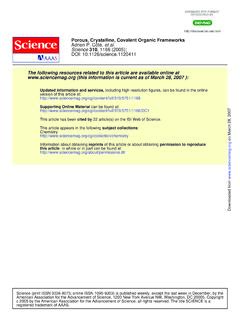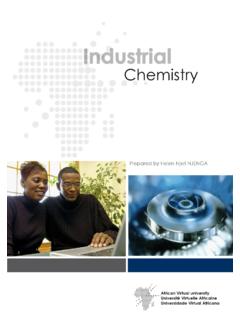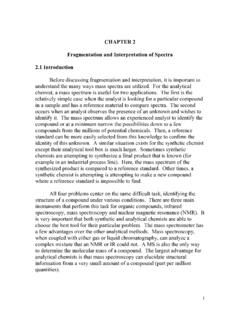Transcription of The Chemistry and Applications of Metal-Organic …
1 DOI: , (2013);341 Science et FurukawaThe Chemistry and Applications of Metal-Organic Frameworks This copy is for your personal, non-commercial use only. clicking , clients, or customers by , you can order high-quality copies for yourIf you wish to distribute this article to others the guidelines can be obtained byPermission to republish or repurpose articles or portions of articles ): August 29, 2013 (this information is current as ofThe following resources related to this article are available online at of this article at: including high-resolution figures, can be found in the onlineUpdated information and services, can be found at: Supporting Online Material #ref-list-1, 13 of which can be accessed free:cites 358 articlesThis article registered trademark of AAAS. is aScience2013 by the American Association for the Advancement of Science; all rights reserved. The title CopyrightAmerican Association for the Advancement of Science, 1200 New York Avenue NW, Washington, DC 20005.
2 (print ISSN 0036-8075; online ISSN 1095-9203) is published weekly, except the last week in December, by theScience on August 29, from The Chemistry and Applications of Metal-Organic Frameworks Hiroyasu Furukawa, Kyle E. Cordova, Michael O Keeffe, Omar M. Yaghi*Background: Metal-Organic frameworks (MOFs) are made by linking inorganic and organic units by strong bonds (reticular synthesis). The fl exibility with which the constituents geometry, size, and functionality can be varied has led to more than 20,000 different MOFs being reported and studied within the past decade. The organic units are ditopic or polytopic organic carboxylates (and other similar negatively charged molecules), which, when linked to metal-containing units, yield archi-tecturally robust crystalline MOF structures with a typical porosity of greater than 50% of the MOF crystal volume. The surface area values of such MOFs typically range from 1000 to 10,000 m2/g, thus exceeding those of traditional porous materials such as zeolites and carbons.
3 To date, MOFs with permanent porosity are more extensive in their variety and multiplicity than any other class of porous materials. These aspects have made MOFs ideal candidates for storage of fuels (hydrogen and methane), capture of carbon dioxide, and catalysis Applications , to mention a : The ability to vary the size and nature of MOF structures without changing their under-lying topology gave rise to the isoreticular principle and its application in making MOFs with the largest pore aperture (98 ) and lowest density ( g/cm3). This has allowed for the selective inclusion of large molecules ( , vitamin B12) and proteins ( , green fl uorescent protein) and the exploitation of the pores as reaction vessels. Along these lines, the thermal and chemical stabil-ity of many MOFs has made them amenable to postsynthetic covalent organic and metal-complex functionalization. These capabilities enable substantial enhancement of gas storage in MOFs and have led to their extensive study in the catalysis of organic reactions, activation of small molecules (hydrogen, methane, and water), gas separation, biomedical imaging, and proton, electron, and ion conduction.
4 At present, methods are being developed for making nanocrystals and supercrystals of MOFs for their incorporation into : The precise control over the assembly of MOFs is expected to propel this fi eld further into new realms of synthetic Chemistry in which far more sophisticated materials may be accessed. For example, materials can be envisaged as having (i) compartments linked together to operate sepa-rately, yet function synergistically; (ii) dexterity to carry out parallel operations; (iii) ability to count, sort, and code information; and (iv) capability of dynamics with high fi delity. Efforts in this direction are already being undertaken through the introduction of a large number of different functional groups within the pores of MOFs. This yields multivariate frameworks in which the varying arrange-ment of functionalities gives rise to materials that offer a synergistic combination of properties. Future work will involve the assembly of chemical structures from many different types of building unit, such that the structures function is dictated by the heterogeneity of the specifi c arrangement of their OUTLINED esign of Ultrahigh PorosityExpansion of Structures by a Factor of 2 to 17 Exceptionally Large Pore AperturesHigh Thermal and Chemical StabilityPostsynthetic Modifi cation (PSM): Crystals as MoleculesCatalytic Transformations Within the PoresGas Adsorption for Alternative Fuels and Separations for Clean AirProton Conductivity for Fuel Cell ApplicationsMOF NanocrystalsThe Materials BeyondSUPPLEMENTARY MATERIALSM aterials and MethodsFigs.
5 S1 to S8 Tables S1 to S5 References (135 363)Related Web sitesCambridge Structural Database reference codes for MOFsMetal-organic framework (MOF) structures are amenable to expan-sion and incorporation of multiple functional groups within their inte-riors. (A) The isoreticular expansion of MOFs maintains the network s topology by using an expanded version of the parent organic linker. Examples of catalysis in MOFs are shown in the large space created by IRMOF-74-XI; Me is a methyl group. (B) Conceptual illustra-tion of a multivariate MOF (MTV-MOF) whose pores are decorated by heteroge-neous mixtures of functionalities that arrange in specifi c sequences. (Back-ground) Optical image of zeolitic imid-azolate framework (ZIF) crystals. 30 AUGUST 2013 VOL 341 SCIENCE 974 REVIEW SUMMARYREAD THE FULL ARTICLE this article as H. Furukawa et al., Science 341, 1230444 (2013). DOI: list of author affi liations is available in the full article online.
6 *Corresponding author. E-mail: by AAAS on August 29, from The Chemistry and Applications ofMetal-Organic FrameworksHiroyasu Furukawa,1,2 Kyle E. Cordova,1,2 Michael O Keeffe,3,4 Omar M. Yaghi1,2,4*Crystalline Metal-Organic frameworks (MOFs) are formed by reticular synthesis, which createsstrong bonds between inorganic and organic units. Careful selection of MOF constituents canyield crystals of ultrahigh porosity and high thermal and chemical stability. These characteristicsallow the interior of MOFs to be chemically altered for use in gas separation, gas storage, andcatalysis, among other Applications . The precision commonly exercised in their chemicalmodification and the ability to expand their metrics without changing the underlying topologyhave not been achieved with other solids. MOFs whose chemical composition and shape ofbuilding units can be multiply varied within a particular structure already exist and may lead tomaterials that offer a synergistic combination of past decade has seen explosive growthin the preparation, characterization, andstudy of materials known as metal-organicframeworks (MOFs).
7 These materials are con-structed by joining metal-containing units [sec-ondary building units (SBUs)] with organic linkers,using strong bonds (reticular synthesis) to createopen crystalline frameworks with permanent po-rosity (1). The flexibility with which the metalSBUs and organic linkers can be varied has ledto thousands of compounds being prepared andstudied each year (Figs. 1 and 2). MOFs have ex-ceptional porosity and a wide range of potentialuses including gas storage, separations, and ca-talysis (2). In particular, Applications in energytechnologies such as fuel cells, supercapacitors,and catalytic conversions have made them ob-jects of extensive study, industrial -scale produc-tion, and application (2 4).Among the many developments made in thisfield, four were particularly important in advanc-ing the Chemistry of MOFs: (i) The geometricprinciple of construction was realized by the link-ing of SBUs with rigid shapes such as squaresand octahedra, rather than the simpler node-and-spacer construction of earlier coordination net-works in which single atoms were linked by ditopiccoordinating linkers (1).
8 The SBU approach notonly led to the identification of a small numberof preferred ( default ) topologies that could betargeted in designed syntheses, but also was cen-tral to the achievement of permanent porosity inMOFs (1). (ii) As a natural outcome of the use ofSBUs, a large body of work was subsequentlyreported on the use of the isoreticular principle(varying the size and nature of a structure withoutchanging its underlying topology) in the designof MOFs with ultrahigh porosity and unusuallylarge pore openings (5). (iii) Postsynthetic mod-ification (PSM) of MOFs incorporating organicunits and Metal-Organic complexes through re-actions with linkers has emerged as a powerfultool for changing the reactivity of the pores ( ,creating catalytic sites) (6). (iv) Multivariate MOFs(MTV-MOFs), in which multiple organic function-alities are incorporated within a single framework,have provided many opportunities for designingcomplexity within the pores of MOFs in a con-trolled manner (7).
9 Below, we focus on these aspects of MOFchemistry because they are rarely achieved in oth-er materials and because they lead to the previous-ly elusive synthesis of solids by design. Unlikeother extended solids, MOFs maintain their under-lying structure and crystalline order upon expan-sion of organic linkers and inorganic SBUs, aswell as after chemical functionalization, whichgreatly widens the scope of this Chemistry . Wereview key developments in these areas and dis-cuss the impact of this Chemistry on applicationssuch as gas adsorption and storage, catalysis, andproton conduction. We also discuss the conceptof MTV-MOFs in relation to the sequence of func-tionality arrangement that is influenced by theelectronic and/or steric interactions among thefunctionalities. Highly functional synthetic crys-talline materials can result from the use of suchtechniques to create heterogeneity within of Ultrahigh PorosityDuring the past century, extensive work was doneon crystalline extended structures in which metalions are joined by organic linkers containing Lewisbase binding atoms such as nitriles and bipyridines(8,9).
10 Although these are extended crystal struc-tures and not large discrete molecules such as poly-mers, they were dubbed coordination polymers a term that is still in use today, although we preferthe more descriptive term MOFs, introduced in1995 (10) and now widely accepted. Becausethese structures were constructed from long or-ganic linkers, they encompassed void space andtherefore were viewed to have the potential to beREVIEW1 Department of Chemistry , University of California, Berkeley,CA 94720, Sciences Division, Lawrence BerkeleyNational Laboratory, Berkeley, CA 94720, ofChemistry, Arizona State University, Tempe, AZ 87240, KAIST Institute and Graduate School of Energy,Environment, Water, and Sustainability (World Class Univer-sity), Daejeon 305-701, Republic of Korea.*Corresponding author. E-mail: of structures)YearDoubling time years20102005200019951990198519801975121 086420No. of MOF structures70006000500040003000200010000 Year201020082006200420022000199819961994 1992199019881986198419821980197819761974 1972 Total (CSD)Extended (1D, 2D, 3D)MOFs (3D)Fig.




